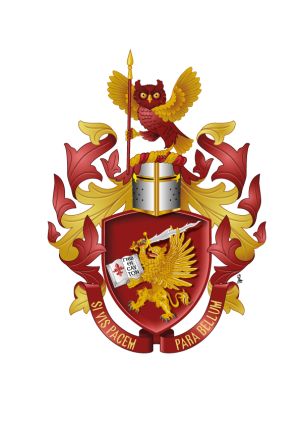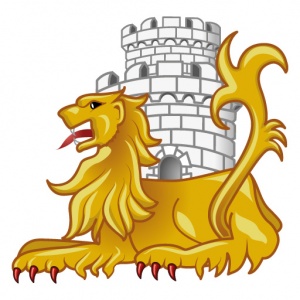Antonios Karagiannis: Difference between revisions
Knorrepoes (talk | contribs) m (Text replacement - "|Arms of {{PAGENAME}}]]" to "|Coat of arms (crest) of {{PAGENAME}}]]") |
Knorrepoes (talk | contribs) m (Text replacement - "====Origin/meaning====" to "===Origin/meaning===") Tags: Mobile edit Mobile web edit |
||
| Line 19: | Line 19: | ||
===Origin/meaning=== | |||
[[File:Karagiannis banner.jpg|thumb|right|Banner of {{PAGENAME}}]] | [[File:Karagiannis banner.jpg|thumb|right|Banner of {{PAGENAME}}]] | ||
Revision as of 09:16, 1 September 2023
| Heraldry of the World Personal arms |
Antonios Karagiannis
Registration no.: 007/2018
Country of origin : Greece
Place of origin : Athens
Granted : No
Granted/officially recorded by : -
Official English blazon
Gules, a griffin segreant Or armed Sable and langued Gules, in the dexter claw (brandishing) bearing aloft a flaming sword Argent hilt Gules and pommel with a fleur de lis Or and in the sinister claw an open book Argent the dexter page charged with a fleur de lis Gules the sinister inscribed with the words ΓΝΩΘΙ ΣΑΥΤΟΝ Sable.
Other language blazon
Origin/meaning
The last name Karagiannis is a nick-name added 4 generations back, instead of the ordinal family last name Leloudas. Αccording to oral family tradition the Leloudas surname comes from the French Lelude, considering a possible blood lineage to the French during the 13th-14th centuries (Frankish Principality of Achaea, Peloponnese, Greece, 1204-1430 AD). The armiger’s family origins from Achaea and Ileia, in Peloponnese.
Colors: a) Or, as a symbol of the sun, elevation of the mind, generosity and a clue to Leloudas/Lelude last name, meaning a glade or light in French and b) Gules, the red color of a warrior, courage, magnanimity and a warrior ancestors tribute. Starting from the sixth great grandfather Tasos Leloudas, fighter of the Greek independence revolution in 1821 to the father Tasos Karagiannis, also a Greek army officer, fighter both of the WW II (El Alamein, Rimini) and the Greek Expeditionary Force in Korea war in 1950.
Shield: a griffin as a symbol of the sun and light. Griffins are flying the chariot of the Greek god Apollo to Hyperboreans and are drawing the chariot of Nemesis, the Greek avenging goddess bearing in her hand a sword.
There is a griffin on the shield of Alexander the Great, depicted in a Hans Burgkmayr engraving (1519 AD - Nine Worthies). Golden rings with engraved griffins have been found as well in Mycenaean tombs in Peloponnese.
Griffins are a medieval representative of the East, under Frankish rule of Morea, the Akova castle in Peloponnese, Greece, named as Mattegriffon, meaning griffins are monsters like the Greeks.
Additionally, a griffin is a symbol of strength, courage, vigilance, valor and perseverance, a guard of treasures and rapidity of execution. It dares all dangers and even death itself. According to one etymological approach the griffin is connected to Christianity by the words "gryps" and "cherub".
The opened book indicates love for knowledge, love for books and an important source for the family, creating a sufficient library.
The fleur-de-lis represents a possible blood lineage to the French.
The flaming sword focus on Christian warriors and the battles they fought against Muslim soldiers, especially during the battle of Agoulinitsa (24/4/1821) and the battle of the Agoulinitsa lagoon (10/11/1825), where the armiger’s ancestor Tasos Leloudas victoriously fought.
The book’s inscription "Know thyself" (in Greek), is the main teaching of Socrates. Through self-knowledge and soul searching, somebody can reach theosis, an esoteric work the armiger’s family applies.
Motto: Si vis pacem, para bellum is a Latin adage translated as "If you want peace, prepare for war" (Vegetius, inspired by Plato at Laws I, 628-629). The armiger states the value of an ongoing preparedness and preparation.
Crest: The owl has a triple symbolism: a) it is a symbol of Athens, the armiger’s birth city, b) a symbol of education, indicating the armiger’s profession and c) a symbol of vigilance, acute wit and associated with spirits. A nocturnal bird of prey with psychic powers, the angel of death, spiritual influence, wisdom, knowledge, inner-knowing and intuition, a messenger between earth and heavenly spirit, can see through deception and illusion, find hidden truths. The bird teaches us to accept the dark side of our personality. The armiger embraces all these aspects.
The spear indicates that the armiger served in Hellenic Armed forces, has a devotion to honor and practices the rules of a gallant knighthood in his everyday life.
Badge: Lion couchant as an emblem of restful vigilance and conscious power, prepared instantly to attack or defend. The White Tower is the symbol of the city of Thessaloniki, where the armiger lives.
Registration details
heraldrydesign.blogspot.com - http://heraldrydesign.blogspot.com/2018/03/blog-post.html
Contact and Support
Partners:
Your logo here ?
Contact us
© since 1995, Heraldry of the World, Ralf Hartemink 
Index of the site












